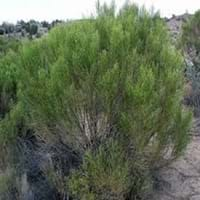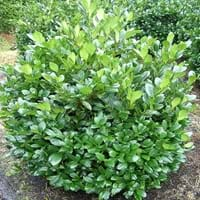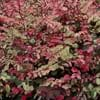Life Span
Perennial
Perennial
Type
Shrub
Broadleaf Evergreen
Origin
Hybrid origin, Southwestern United States
Eastern Europe, Western Asia
Types
Not Available
Castlewellan, Otto Luyken, Schipkaensis
Number of Varieties
Not Available
Habitat
riparian zones, Semi desert, Upland
Lowland evergreen rainforest
USDA Hardiness Zone
8-10
6-9
AHS Heat Zone
12-1
Not Available
Sunset Zone
7, 8, 9, 10, 11, 12, 13, 14
21,22
Habit
Spreading
Spreading
Flower Color Modifier
Not Available
Bicolor
Fruit Color
creamy white
Black
Leaf Color in Spring
Green
Dark Green
Leaf Color in Summer
Green
Dark Green
Leaf Color in Fall
Green
Dark Green
Leaf Color in Winter
Green
Dark Green
Leaf Shape
Oblanceolate , Ovate
broad, flat
Plant Season
Spring, Summer, Fall, Winter
Spring, Summer, Fall, Winter
Sunlight
Full Sun
Full Sun, Partial Sun, Partial shade, Full Shade
Type of Soil
Clay, Loam, Sand
Clay, Loam
The pH of Soil
Acidic, Neutral, Alkaline
Acidic, Neutral
Soil Drainage
Well drained
Well drained
Tolerances
Drought, Dry soil, Heat Tolerance
Drought, Salt
Where to Plant?
Ground, Pot
Ground
How to Plant?
Seedlings
Softwood cuttings
Plant Maintenance
Medium
Medium
Watering Requirements
Needs very little water
Keep the Soil well drained, Provide sufficient water to saturate the root zone, Use Mulches to help prevent water loss during hot and windy weather
In Summer
Lots of watering
Lots of watering
In Spring
Moderate
Moderate
In Winter
Average Water
Average Water
Soil pH
Acidic, Neutral, Alkaline
Acidic, Neutral
Soil Type
Clay, Loam, Sand
Clay, Loam
Soil Drainage Capacity
Well drained
Well drained
Sun Exposure
Full Sun
Full Sun, Partial Sun, Partial shade, Full Shade
Pruning
Cut back old stems to the ground, Remove damaged leaves, Remove dead branches, Remove dead leaves
Remove damaged leaves, Remove dead branches, Remove dead leaves
Fertilizers
can go long without fertilizers
All-Purpose Liquid Fertilizer
Pests and Diseases
Pests and diseases free
Red blotch
Plant Tolerance
Dry Conditions, Dry soil, Heat And Humidity
Drought
Flower Petal Number
Single
Single
Foliage Texture
Fine
Medium
Foliage Sheen
Glossy
Glossy
Attracts
Butterflies
Bees, Birds, Insects
Allergy
Unknown
Not Available
Aesthetic Uses
along a porch, deck or patio, Beautification, Ground Cover, Showy Purposes, Wild gardens
Informal Hedge
Beauty Benefits
Not Available
Not Available
Edible Uses
Sometimes
Yes
Environmental Uses
Air purification
Air purification
Medicinal Uses
anti-inflammatory, Anti-oxidant, cholesterol-lowering
Eye Infection, Nausia, Vomiting
Part of Plant Used
Twigs
extracted oil
Other Uses
Can be made into a herbal tea
Dried heads are used in floristry
Used As Indoor Plant
No
No
Used As Outdoor Plant
Yes
Yes
Garden Design
Groundcover
Foundation, Hedges, Mixed Border
Botanical Name
BACCHARIS 'Centennial'
PRUNUS laurocerasus 'Otto Luyken'
Common Name
desert broom , broom baccharis , greasewood
cherry laurel, common laurel
In Hindi
desert broom
English laurel
In German
Wüste Besen
Lorbeerkirsche
In French
desert broom
Laurier-cerise
In Spanish
escoba del desierto
Prunus laurocerasus
In Greek
desert broom
Prunus laurocerasus
In Portuguese
vassoura do deserto
Prunus laurocerasus
In Polish
desert broom
Laurowiśnia wschodnia
In Latin
desert broom
Prunus padus
Phylum
Magnoliophyta
Tracheophyta
Class
Magnoliopsida
Magnoliopsida
Family
Asteraceae
Rosaceae
Clade
Angiosperms, Asterids, Eudicots
Angiosperms, Eudicots, Rosids
Tribe
Astereae
Not Available
Subfamily
Not Available
Not Available
Number of Species
Not Available
Importance of Desert Broom and English Laurel
Want to have the most appropriate plant for your garden? You might want to know the importance of Desert Broom and English Laurel. Basically, these two plants vary in many aspects. Compare Desert Broom and English Laurel as they differ in many characteristics such as their life, care, benefits, facts, etc. Every gardener must at least have the slightest clue about the plants he wants to plant in his garden. Compare their benefits, which differ in many ways like facts and uses. The medicinal use of Desert Broom is anti-inflammatory, Anti-oxidant and cholesterol-lowering whereas of English Laurel is Eye Infection, Nausia and Vomiting. Desert Broom has beauty benefits as follows: Not Available while English Laurel has beauty benefits as follows: Not Available.
Compare Facts of Desert Broom vs English Laurel
How to choose the best garden plant for your garden depending upon its facts? Here garden plant comparison will help you to solve this query. Compare the facts of Desert Broom vs English Laurel and know which one to choose. As garden plants have benefits and other uses, allergy is also a major drawback of plants for some people. Allergic reactions of Desert Broom are Unknown whereas of English Laurel have Not Available respectively. Having a fruit bearing plant in your garden can be a plus point of your garden. Desert Broom has no showy fruits and English Laurel has no showy fruits. Also Desert Broom is not flowering and English Laurel is not flowering . You can compare Desert Broom and English Laurel facts and facts of other plants too.





